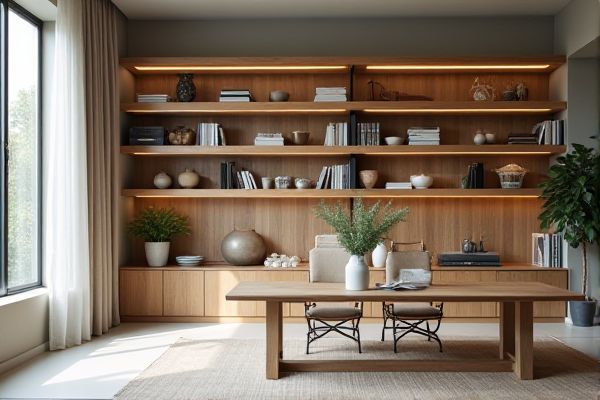
Glass front cabinets protect your items from dust while allowing you to showcase your beautiful dishes and glassware, blending functionality with style. Discover how to choose between glass front and open shelving to best suit Your kitchen's aesthetic and practical needs by exploring the rest of the article.
Table of Comparison
| Feature | Glass Front Shelving | Open Shelving |
|---|---|---|
| Visibility | Protected clear view of items | Full open view, easy access |
| Protection | Dust and debris resistant | Exposed to dust and dirt |
| Design Style | Sleek, modern, elegant look | Casual, rustic, or minimalist |
| Maintenance | Requires frequent glass cleaning | Easy to clean, but dusts surfaces |
| Weight Capacity | Generally sturdy, supports heavy items | Depends on material and mounting |
| Cost | Typically higher due to materials | Usually lower cost option |
| Organization | Encourages neat display | Prone to clutter without discipline |
| Installation | Requires professional installation | Simple DIY installation possible |
Introduction to Glass Front and Open Shelving
Glass front cabinets feature transparent panels that protect dishes and decor while showcasing their contents, combining style and functionality in kitchen design. Open shelving offers easy access and an airy feel, allowing homeowners to display frequently used items and personalized kitchenware prominently. Both options enhance kitchen aesthetics, with glass fronts providing a polished look and open shelves contributing to a casual, spacious environment.
Aesthetic Differences: Glass Front vs Open Shelving
Glass front cabinets offer a sleek, polished look by showcasing items behind clear or frosted panes, enhancing your kitchen's elegance while protecting contents from dust. Open shelving provides a more casual, airy aesthetic that allows for easy access and display of frequently used dishes or decorative pieces. Choosing between them depends on whether you prioritize a refined, contained appearance or a relaxed, open feel in your space.
Storage and Accessibility Comparison
Glass front shelves offer protection from dust and provide clear visibility of stored items, enhancing your ability to locate belongings quickly while maintaining an organized display. Open shelving allows immediate access and encourages frequent use, though it requires more maintenance to keep items clean and visually appealing. Balancing storage needs with accessibility depends on your preference for display aesthetics versus ease of reach.
Visual Impact on Kitchen Space
Glass front cabinets create a sleek, polished look that visually expands your kitchen by reflecting light and showcasing organized dishware. Open shelving offers an airy, accessible feel that highlights decorative items and adds personality but can make the space appear more cluttered if not carefully styled. Choosing between glass fronts and open shelving depends on how you want to balance elegance with practicality in your kitchen's visual impact.
Organization and Display Capabilities
Glass front cabinets offer enhanced organization by protecting items from dust while allowing clear visibility, making it easier to showcase decorative dishes and glassware. Open shelving maximizes display space and provides quick access but requires meticulous arrangement to maintain a tidy appearance and prevent clutter. Both options balance aesthetics and functionality, with glass fronts favoring protection and open shelves emphasizing accessibility and visual openness.
Maintenance and Cleaning Requirements
Glass front cabinets require regular cleaning to remove fingerprints, smudges, and dust for a clear, polished appearance. Open shelving demands frequent dusting and organizing to prevent buildup and maintain an uncluttered look. Your choice depends on how much time you want to invest in upkeep and whether you prefer protection from dust or easy access.
Durability and Material Considerations
Glass front cabinets offer superior protection against dust and moisture, preserving dishware and reducing cleaning frequency, while typically being made from tempered glass for enhanced durability. Open shelving demands materials resistant to humidity and frequent cleaning, such as solid hardwood or treated metal, to withstand daily use and exposure without warping or corrosion. Choosing between glass fronts and open shelves hinges on balancing material longevity with maintenance needs in varying kitchen environments.
Cost Comparison: Glass Front vs Open Shelves
Glass front cabinets typically cost 20-30% more than open shelving due to the expense of glass panels and additional framing materials. Open shelves are more budget-friendly, requiring less material and labor for installation, making them ideal for cost-conscious renovations. Maintenance costs also differ, with glass fronts demanding regular cleaning to maintain transparency, while open shelves accumulate dust more quickly, necessitating frequent dusting.
Best Use Cases for Each Option
Glass front shelving is ideal for displaying decorative dishes and glassware while keeping items protected from dust, making it perfect for formal dining rooms or kitchens with curated collections. Open shelving suits frequent-use essentials and casual kitchenware, providing easy access and encouraging a more relaxed, airy feel in kitchens and living spaces. Your choice depends on whether you prioritize display and protection or accessibility and openness in your storage needs.
Choosing the Right Style for Your Kitchen
Glass fronts offer a sleek, modern look that protects your dishes from dust while allowing you to display your favorite glassware or colorful crockery. Open shelving creates an airy, accessible vibe perfect for everyday use and showcasing frequently used items, enhancing your kitchen's personality. Consider your lifestyle and maintenance preferences to choose the style that best suits your kitchen's functionality and aesthetic, ensuring your space remains both practical and visually appealing.
 homyna.com
homyna.com